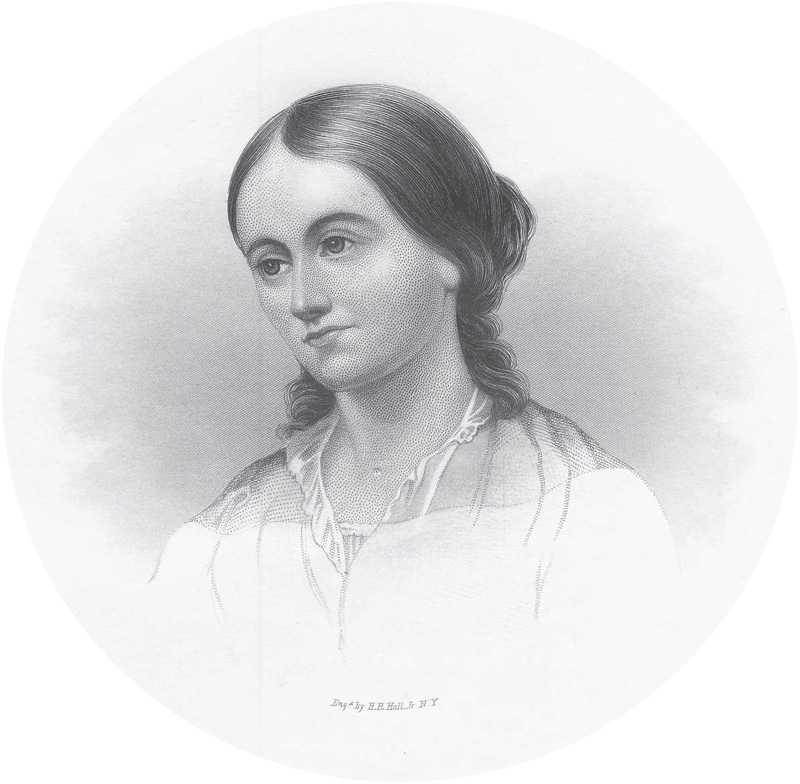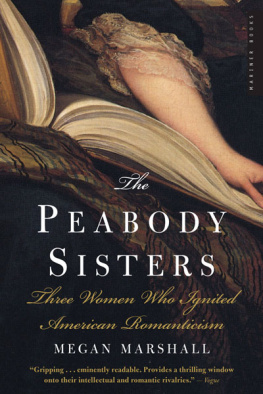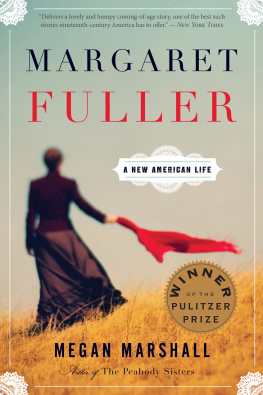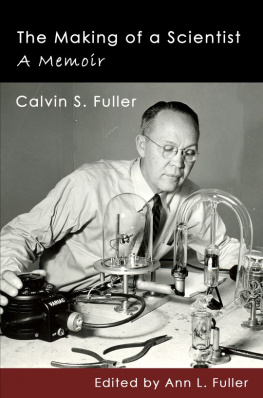Copyright 2013 by Megan Marshall
All rights reserved
For information about permission to reproduce selections from this book, write to Permissions, Houghton Mifflin Harcourt Publishing Company, 215 Park Avenue South, New York, New York 10003.
www.hmhbooks.com
The Library of Congress has cataloged the print edition as follows:
Marshall, Megan.
Margaret Fuller : a new American life / Megan Marshall.
pages cm
ISBN 978-0-547-19560-5 (hardback)
1. Fuller, Margaret, 18101850. 2. Authors, American19th centuryBiography. 3. FeministsUnited StatesBiography. I. Title.
PS 2506. M 37 2013
818'.309dc23
[B 2012042179
e ISBN 978-0-547-52362-0
v2.0313
In memory of
E.S.
E.S.M.
&
E.W.M.M.
Where I make an impression it must be by being most myself.
Margaret Fuller to her editor John Wiley, 1846
List of Illustrations
FRONTISPIECE ()
Margaret Fuller, engraving by Henry Bryan Hall Jr. Graphics File, Prints & Drawings, National Portrait Gallery, Smithsonian Institution.
PART I ()
Timothy Fuller, portrait by Rufus Porter. Fruitlands Museum, Harvard, Mass., F.1992.6.
Margarett Crane Fuller, daguerreotype, c. 1840s. Courtesy of Frances Fuller Soto.
The Old Hovey Tavern, Cambridgeport, Which Was Burned June 12th 1828, lithograph, c. 1820s. Boston Athenaeum, Prints and Photographs Dept., B B64C1 Hot.h.(no.1).
PART II ()
Margaret Fuller, sketch by James Freeman Clarke. Houghton Library, Harvard University, MS Am 1569.3 (11).
James Freeman Clarke, sketch by his sister, Sarah Freeman Clarke. Houghton Library, Harvard University, MS Am 1569.3 (10).
Perspective View of the Seat of the Hon. Francis Dana, watercolor by Jacob Bigelow, 1806, for his Harvard College mathematical thesis. Harvard University Archives, HUC 8782.514 (126).
PART III ()
Photograph of 108 Pleasant Street, Farmers Row, Groton. Courtesy of Groton Historical Society, Groton, Mass.
The Greene Street School, Providence, lithograph. Courtesy of the Rhode Island Historical Society, RHi X17 371.
)
Caroline Sturgis, portrait. Courtesy of the Sturgis Library, Barnstable, Mass.
Samuel Gray Ward, salt print photograph. Boston Athenaeum, Prints and Photographs Dept., AA 5.4 Ward.s.(no.1).
Anna Barker Ward, oil portrait by William Morris Hunt. Private collection.
Margaret Fuller, photograph, Southworth and Hawes, 1850-55, after a daguerreotype by John Plumbe, 1846. Museum of Fine Arts, Boston, Gift of Edward Southworth Hawes in memory of his father, Josiah Johnson Hawes, 43.1412.
Ralph Waldo Emerson, daguerreotype. Courtesy of Concord Free Public Library, Concord, Mass.
Ellery Channing, portrait. Courtesy of J. C. Marriner.
Ellen Kilshaw Fuller, daguerreotype. Courtesy of Frances Fuller Soto.
PART V ()
New York City Hall, Park and Environs, c. 1849, lithograph by John Bachmann. From the collection of the New-York Historical Society.
PART VI ()
George Sand, sketch, oil on canvas, by Thomas Couture, c. 1848. Courtesy of Runion des Muses Nationaux/Art Resource, N.Y.
Adam Mickiewicz, drawing by Kazimierz Mordasewicz, 1898, after a daguerreotype of 1839 by an unknown artist. Courtesy of Muzeum Literatury Adama Mickiewicza, Warsaw.
Giovanni Angelo Ossoli, daguerreotype. Houghton Library, Harvard University, MS AM 1086.1.
PART VII ()
Tassos Oak, Rome, engraving by J. G. Strutt belonging to Margaret Fuller, inscribed From the Wreck of the Elizabeth. Courtesy of Lucilla Fuller Marvel.

Margaret Fuller, engraving by Henry Bryan Hall Jr.
Prologue
T HE ARCHIVIST PLACED THE SLIM VOLUME, AN ORDINARY composition book with mottled green covers, in a protective foam cradle on the library desk in front of me. When I opened it, I knew I would find pages filled with a familiar looping script, a forward-slanting hand that often seemed to rush from one line to the next as if racing to catch up with the writers coursing thoughts.
But this notebook was different from any other Id seen: it had survived the wreck of the Elizabeth off Fire Island in July 1850, packed safely in a trunk that floated to shore, where grieving friends retrieved the soggy diary and dried it by the fire. The green pasteboard cover had pulled away from its backing; the pages were warped at the edges in even ripples. This was Margaret Fullers last known journal. Its contents were all that remained to hint at what she might have written in her famous lost manuscript on the rise and fall of the 1849 Roman Republic, the revolution she had barely survived. The manuscript itselfwhat is most valuable to me if I live of any thinghad been swept away more than a century and a half ago in a storm of near hurricane force, along with Margaret, her young Italian husband, and their two-year-old son, all of them passengers on the ill-fated Elizabeth.
I opened the cover and read what appeared to be a message directed to me, or to anyone else who might choose to study this singular document. The words, written on a white index card, had not been penned in Margaret Fullers flowing longhand, but rather penciled in a primly vertical script formed in a decade closer to mineby a descendant? an earlier biographer? a library cataloguer? Two brief lines carried a judgment on the volume, and on Margaret herself: Nothing personal, public events merely. The nameless reader, like so many before and since, had been searching Margaret Fullers private papers for clues to the mysteries in her personal lifeHad she really married the Italian marchese she called her husband? Was their child conceived out of wedlock?and found the evidence lacking.
I turned the pages, reading at random. In the early passages, Margaret recalled her arrival at Naples in the spring of 1847 at age thirty-six, her first acquaintance with the fig and olive, and sightseeing in Capri and Pompeii before traveling overland to Rome. Having grown up a prodigy of classical learning in Cambridge, Massachusetts, Margaret had long wished to make this journey. Yet perhaps it was for the best that a reversal in family fortune kept her in New England through her early thirties. She had made a name for herself among the Transcendentalists, becoming Emersons friend and Thoreaus editor before moving to New York City for an eighteen-month stint as front-page columnist for Horace Greeleys New-York Tribune, which led to this belated European tour in a triumphal role as foreign correspondent, witness to the revolutions that spread across the Continent beginning in 1848.
Flipping ahead to January 1849, I read of the exiled soldier-politicians Garibaldi and Mazzini greeted in Rome as returning heroes and of a circular posted by the deposed Pope Pius IX, excommunicating any citizen who had aided in the assassination of his highest deputy the previous November: The people received it with jeers, tore it at once from the walls. ThenMonstrous are the treacheries of our time!French troops, dispatched to restore the pope to power, had landed just fifty miles away on the Mediterranean coast, at Civitavecchia. Finally, on April 28: Rome is barricaded, the foe daily hourly expected. These vivid entries, brief as they were, would anchor my narrative of Margarets Roman years. Public events merely?
How extraordinary it was to find a womans private journal filled with such accounts. Yet the inscriber of the index card had found the contents disappointing. Would any reader fault a manespecially an internationally known writer and activist, as Margaret Fuller wasfor keeping a journal confined to public events through a springtime of revolution? Margaret well understood this limited view of women and the consequences for those who overstepped its bounds. She herself had scorned those who censured her personal heroines, Mary Wollstonecraft and George Sand, for flouting the institution of marriage; Margaret had been appalled that critics will not take off the brand once it had been set upon these unconventional women, even after they found their way to purer airin death. Margarets own legacy had been clouded by the same prurient attention, often leading to condemnation, always distracting attention from her achievements.
Next page








